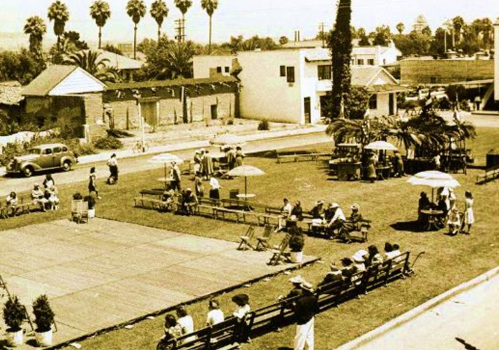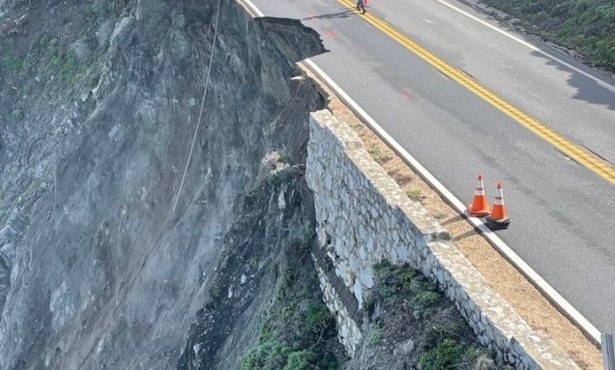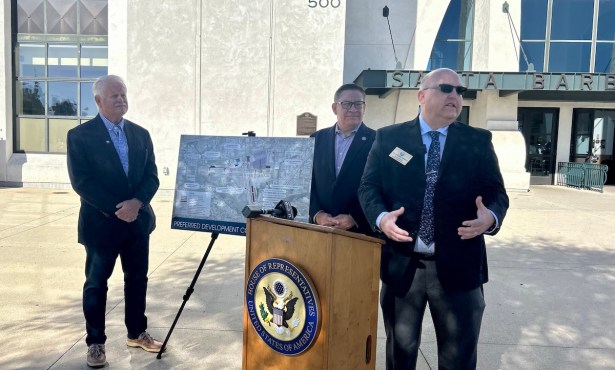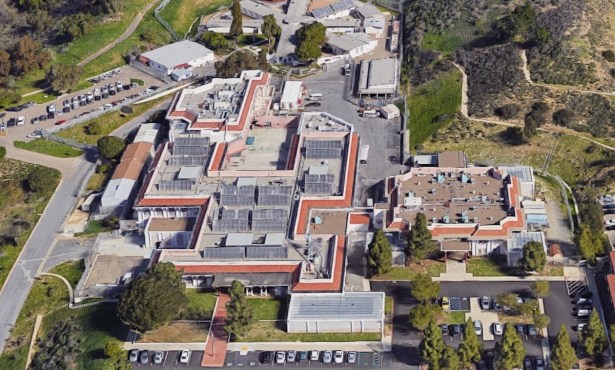Debate over Santa Barbara’s De la Guerra Plaza Goes Back 100 Years
New Revitalization Plans Featuring Hardscape in Place of Grass Move Forward Despite Concerns

[Click to enlarge] De la Guerra Plaza rendering, view from De la Guerra St. | Credit: Courtesy
The latest plans for De la Guerra Plaza recently achieved unanimous approval during a concept review with the City of Santa Barbara’s Historic Landmarks Commission (HLC), though the journey to this point has been anything but smooth. After debates over the grass lawn — which was nixed in favor of hardscape — the pavilion stage feature, and several redesigns, the current plans resemble a classic European city square.
RRM Design Group’s proposal will raise the entire plaza to create one even surface, and will include new landscaping, a bubbler water feature, and a Chumash mosaic. The redesign has been a long time coming, but with so many past efforts that failed for lack of public support, lack of consensus on design, or natural disaster, will this be the one that finally makes it through?

[Click to enlarge] De la Guerra Plaza rendering, view looking north toward City Hall from Storke Placita. | Credit: Courtesy
Birth of the Plaza
In the early 19th century, José De la Guerra worked his way up through the ranks at the Presidio of Santa Barbara, eventually becoming its commandant in 1827. As one of the most wealthy landowners of the time, De la Guerra owned five large ranches and more than a half-million acres across the state. But, according to a historical report written by Santa Barbara Trust for Historic Preservation Executive Director Anne Petersen, his family home, Casa De la Guerra, which he built in 1828, was the “urban seat” of his empire.

The plaza was originally the courtyard of the home, where De la Guerra would host community events and multi-day wedding celebrations. In 1853, three years after Santa Barbara was established as a city in the new state of California, De la Guerra’s son and newly appointed mayor, Francisco De la Guerra, officially declared the plaza as a city public space.
In 1874, the first City Hall was constructed right in the middle of the plaza, along with a firehouse and three-cell city jail, for a cost of around $8,000. In her historical summary, Petersen says the decision to build the new city hall in the center of the plaza was a “clear and perhaps intentional subversion” of Santa Barbara’s Spanish roots. At the time, the plaza was commonly referred to as “City Hall Plaza.”
By the 1920s, Santa Barbara started to reconnect with its earlier roots, in much part due to the “father of architectural planning” in the city, Bernhard Hoffmann, who led the efforts to restore Casa De la Guerra to its original appearance. Along with the house, Hoffmann helped develop El Paseo into a retail and office space that laid the blueprint to the city’s now ubiquitous Spanish Colonial Revival style. Hoffmann called his vision a “City in Spain.”
Into the Modern Age
Starting in 1923, architects Roland Sauter and E. Keith Lockard started the restoration of De la Guerra Plaza with construction of the current City Hall building, abandoning the original building and introducing the current configuration with a ring of buildings around a central plaza, anchored by the new city hall on one side and freshly built News-Press building on the other end.
While the overall shape of the plaza was set, the community spent the next few years disagreeing over what should go in the middle. There were plenty of ideas — a water fountain, picnic benches, a performance stage, statues — but there was never a consensus, and while the arguments carried on, the plaza’s grass lawn and driveway popped up as a temporary fix. According to a 2008 historic report on the plaza: “A consensus could not be reached as to an appropriate design for the square itself. In the interim the open space was simply graded and planted with grass within the existing concrete curbing that surrounded the center of the plaza.”
In 1925, the earthquake that ripped through the city took priority over the plaza plans, as local efforts focused on rebuilding and recovering. The following years saw the true emergence of the white plaster walls and red-tile roof that came to define the city’s Spanish Revival style.
Over the next few decades, the plaza remained much in its current form. There were ideas for a recreation center that were abandoned in the midst of World War II; an abandoned proposal for fallout shelters during the Cold War era of the 1950s; and several plans to create a pedestrian-only space, though none of the designs gained enough support.
Time for a Change
In recent years, De la Guerra Plaza has hosted annual events such as Fiesta’s El Mercado De la Guerra, along with other special gatherings, concerts, and public rallies. It is often the site of choice for community protests, with speakers set up on the lawn and crowds gathered in the center.
But as time passed, the city kept exploring a new era for the plaza. Over the past century, a long list of architects have attempted to give their own vision to the plaza. Back in 1923, prominent architect George Washington Smith put forward his original concept for a pedestrian-only plaza with hardscape and a central water fountain.
Similar proposals followed in the ’60s, ’80s and ’90s, and perhaps the furthest the project ever made it was after an in-depth historical evaluation by architectural historians Tim Hazeltine and Pamela Post in 2008. Following that report, the city began to take a real inventory on what had to be preserved and what could be removed or altered. The main elements — City Hall, the News-Press building and the Bothin Building — were all to be preserved, as were the historic Washingtonia palm and pepper trees. The concrete curbs, asphalt paving, and lawn could all be removed if necessary.
Those efforts fizzled in 2012 when the city redevelopment agency was dissolved, but in 2019 the city started working toward the revitalization in earnest, forming a De la Guerra Plaza Revitalization Advisory Committee and working with RRM Design Group toward a concept that debuted at an HLC meeting in February 2021.
The 2021 plans included a “splash pad” water feature, kiosk, arcade, and a pedestrian-only hardscape that paid homage to Smith’s original 1923 vision.
Debate Isn’t Over
The grass lawn in De la Guerra Plaza dates back nearly a hundred years, when it took the place of the original City Hall that was replaced and demolished. And although the layout has been adjusted twice since then to make room for modern traffic, the grass turf section has always been a central feature.
But RRM’s new plans would raise the ground level to be even with the sidewalks and replace the grass and pavement with stone walkways. The plans drew criticism from city residents, and a few commissioners who hoped to save the lawn. In April 2022, during a joint meeting between the plaza advisory committee and HLC, the city took its official position that the grass was not sustainable.
The city’s water conservation standards and “green building” policy required that new or renovated projects be designed “without the use of decorative turf unless approved for recreational purposes,” and the city said it would cost more than $850,000 to pump recycled water from the nearest main more than 3,300 feet away. The advisory committee, city administration, Public Works, Parks and Recreation, and Community Development departments all agreed that the project should not include grass.
On August 2, the HLC unanimously voted to continue with the project, which is now a much simpler design, with brick and sandstone walkways and a pavilion stage between the plaza and the parking lot. The “splash pad” has also been replaced with a Chumash mosaic with a “bubbler” water feature.
During the meeting, there were still echoes of the decades-long debate over the grass, with Commissioner Cass Ensberg urging the project planners to consider exploring a way to keep the lawn. “Just think about it,” she said, “because once we go here, we can’t easily go back.”
While the project is moving forward, it still needs to go through formal planning and review for design approval.




You must be logged in to post a comment.